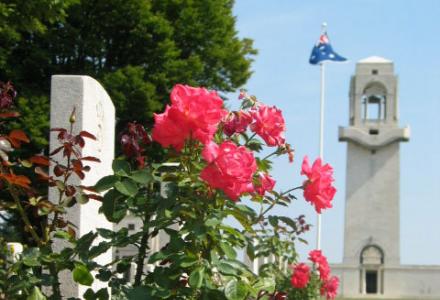‘Anzac’ meant everything to Mary Booth. A patriot and imperialist at one and the same time, she helped to create the legend we live with today.
Dr Booth founded the Soldiers’ Club in Sydney, a vibrant social centre offering nourishing meals, (non-intoxicating) drinks, and healthy entertainments for men on leave. And well before the war was won, Mary Booth channelled the rhetoric of Anzac into the work of remembrance. Under her leadership, each Anzac Day, groups of women (most with loved ones still serving overseas) decorated the graves of returned servicemen who had died of illness or wounds.
At war’s end, Booth led what she called an Anzac pilgrimage to the wharves at Woolloomooloo. Every April the gates there were ‘hung all over with flowers’, sprigs of rosemary, handwritten messages and other ‘tokens of remembrance’. Honouring those men became the mission of the Anzac Fellowship of Women, yet another group Dr Booth founded in 1921. It continued its work—with Booth as president—until 1956, and was the only civilian organisation granted the right by Prime Minister Hughes to use the name ‘Anzac’.
Few idealised the Anzacs as much as Mary Booth; few were as intimately involved in the making of the Anzac mythology. But Mary Booth was also acutely aware of what might well be called the ugliness of Anzac—the appalling human consequences of war and the failings of the Anzac himself.
In 1916 Dr Booth set up the Centre for Soldiers’ Wives and Mothers to care for the women the Anzacs left behind. Throughout the war—and well beyond it—she organised charitable assistance for women beaten, abandoned, abused or neglected by their men. Although Booth supported marriage as an institution, she was also an outspoken feminist. Women wronged by ‘bad men’ should stand up for their rights, demand their share of a returned man’s entitlement, and leave relationships that were clearly loveless and abusive.
Mary Booth’s story alerts us to a paradox. She was both a pioneering social reformer and a political conservative; an Australian nationalist and an Empire enthusiast; an advocate of domestic science and an outspoken feminist. All these conflicting currents came together under the aegis of Anzac. Her story highlights women’s victimhood but also their agency; it reveals the way women fashioned the first commemorative protocols and the way they came to be marginalised in the dominant discourse of remembrance. Finally, she provides a model of the ‘New Woman’ who came into her own in the post-war period; mobile, educated, confident and articulate, prepared (in short) to challenge the age-old privileges of men.



